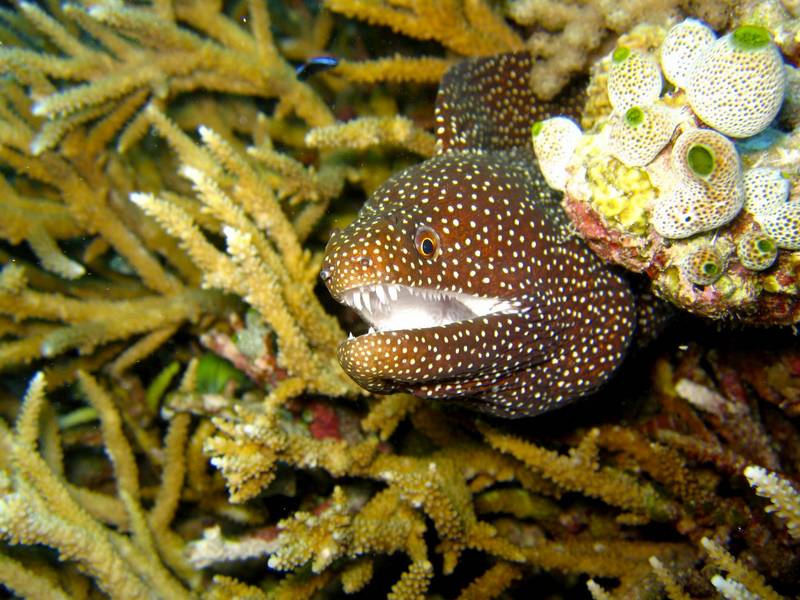Moray Eel (Family: Muraenidae) - Wiki {!--곰치류--> Moray eel
From Wikipedia, the free encyclopedia
[Photo] Picture of a moray eel taken on the Maldives by Michael Str??ck (mstroeck) in 10 November 2006. Released under the GFDL. Photo by http://en.wikipedia.org/wiki/User:Mstroeck
Moray eels are large cosmopolitan eels of the family Muraenidae. There are approximately 200 species in 15 genera. The typical length for a moray is 1.5 m (5 ft), with the largest being the slender giant moray, Strophidon sathete, at up to 4 m (13 ft).
Anatomy
The dorsal fin of the moray extends from just behind the head, along the back and joins seamlessly with the caudal and anal fins. Most species lack pectoral and pelvic fins, adding to their snake-like appearance. Their eyes are rather small; morays rely on their highly developed sense of smell, lying in wait to ambush prey.
The body of the moray is patterned, camouflage also being present inside the mouth. Their jaws are wide, with a snout that protrudes forward. They possess large teeth, designed to tear flesh as opposed to holding or chewing.
Moray eels have a second set of jaws in their throat called pharyngeal jaws, that also possess teeth. When feeding, morays launch these jaws into the oral cavity, where they grasp struggling prey and transport it into the throat and down to the rest of the digestive system. Moray eels are the only known type of animal that uses pharyngeal jaws to actively capture and restrain prey.
Morays are capable of inflicting serious wounds to humans.
Morays secrete a protective mucus over their scaleless skin which contains a toxin in some species. Their small circular gills, located on the flanks far posterior to the mouth, require the moray to maintain a gape in order to facilitate respiration.
Morays are carnivorous and feed primarily on other fish, cephalopods, mollusks, and crustaceans. Groupers, other morays, and barracudas are among their few predators. There is a commercial fishery for several species, but some have been known to cause ciguatera fish poisoning. Morays hide in crevices in the reefs, and wait until their prey is close enough for capture. They then jump out and clamp the prey in their strong jaws.
Behavior
Cooperative hunting
In the December 2006 issue of the journal, Public Library of Science Biology, a team of biologists announced the discovery of interspecies cooperative hunting involving morays. The biologists, who were engaged in a study of Red Sea cleaner-fish (fish that enter the mouths of other fish to rid them of parasites), discovered that a species of reef-associated grouper, the roving coralgrouper (Plectropomus pessuliferus), often recruited morays to aid them while hunting for food. This is the first discovery of cooperation between fish in general, and the first known inter-species cooperation outside of humans and dogs, humans and falcons, humans and cats, and humans and dolphins.
Reputation
Morays have sometimes been described as vicious or ill-tempered. In fact, morays are shy and secretive, and they only attack humans in self-defense. They also accidentally bite human fingers when being fed, because it cannot see or hear very well, although they have an acute sense of smell. Morays hide from humans and would rather flee than fight. Morays, however, do inflict a nasty bite, because, although not poisonous, their backward-pointing teeth are covered with bacteria which may infect the wound. Another danger that morays present is when they are eaten. If the eels have eaten algae, or fish that have eaten algae, they will cause ciguatera food poisoning if eaten.
Habitat
Morays frequent tropical and subtropical coral reefs to depths of 200 m, where they spend most of their time concealed inside crevices and alcoves.
Classification
Genera
Anarchias
Channomuraena
Cirrimaxilla
Echidna
Enchelycore
Enchelynassa
Gymnomuraena
Gymnothorax
Monopenchelys
Muraena
Pseudechidna
Rhinomuraena
Scuticaria
Strophidon
Uropterygius
http://en.wikipedia.org/wiki/Moray_eel
| The text in this page is based on the copyrighted Wikipedia article shown in above URL. It is used under the GNU Free Documentation License. You may redistribute it, verbatim or modified, providing that you comply with the terms of the GFDL. |
